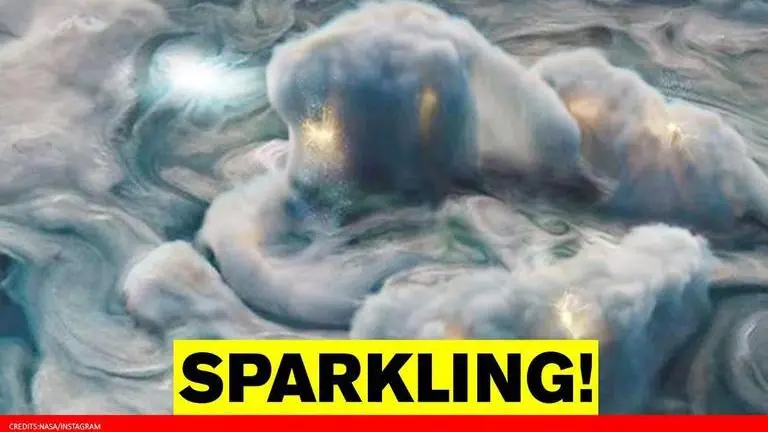Updated 6 August 2020 at 07:52 IST
NASA's Juno mission spots 'shallow lightning' across Jupiter's cloud tops
NASA’s Juno spacecraft recently spotted ‘sparkling’ high-altitude electrical storms zip across our solar system’s largest planet. See the picture here:
- Science News
- 3 min read

NASA’s Juno spacecraft recently spotted ‘sparkling’ lightning storms zip across our solar system’s largest planet. On August 5, the US space agency took to Instagram to share an illustration of Jupiter that was formed using the data obtained by the Juno mission. The picture depicts the high-altitude electrical storms, also known as ‘shallow lightning', on Jupiter.
According to a press note, the ‘shallow lightning’ is an unexpected form of electrical discharge that originates from clouds containing an ammonia-water solution. In post, NASA explained that it was previously believed that lightning on Jupiter was similar to Earth. However, with the flashes observed at altitudes too cold for pure liquid water to exist “told a different story”.
Take a look at the post here:
Heidi Becker, Juno's Radiation Monitoring Investigation lead at NASA's Jet Propulsion Laboratory in Southern California, said that the spacecraft's close flybys of the cloud tops allowed the scientists to see something surprising – smaller, shallower flashes – originating at much higher altitudes in Jupiter's atmosphere than previously assumed possible.
Advertisement
The Juno team suggests that Jupiter’s powerful thunderstorm fill water-ice crystals high up into the planet’s atmosphere ammonia vapour that melts the ice, forming a new ammonia-water solution
‘Mushballs’: Ammonia-rich hailstones
The NASA scientists also found that the violent thunderstorms, for which the gaseous planet is known, may form slushy ammonia-rich hailstones. Juno’s mission team called the hailstones ‘mushballs’ and theorised that they essentially trap ammonia and water in the upper atmosphere and carry them into the depths of Jupiter’s atmosphere.
Advertisement
The scientists said that the 'mushballs' are generated in a similar manner as hail on Earth. Tristan Guillot, Juno co-investigator from Université Côte d'Azur in Nice, France said, "The mushballs get so big, even the updrafts can't hold them, and they fall deeper into the atmosphere, encountering even warmer temperatures, where they eventually evaporate completely”.
She further added, “Their action drags ammonia and water down to deep levels in the planet's atmosphere. That explains why we don't see much of it in these places with Juno's Microwave Radiometer”.
Juno arrived at Jupiter in 2016 and since then has gotten much closer to the giant planet’s cloud tops. According to NASA, since its ascend on the planet, the solar-power Jupiter explorer has performed 27 science flybys and logged over 300 million miles.
Juno is part of NASA's New Frontiers Program, which is managed at NASA's Marshall Space Flight Center in Huntsville, Alabama, for the agency's Science Mission Directorate in Washington.
Published By : Bhavya Sukheja
Published On: 6 August 2020 at 07:52 IST
